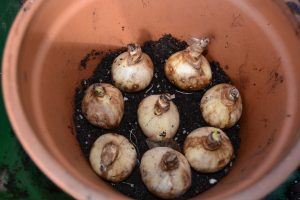With Autumn barely beginning to hit its crimson and gold stride, it may be hard to think about Spring–but to enjoy those tulips, daffodils, and other beautiful bulbs next year, it’s time to get growing!
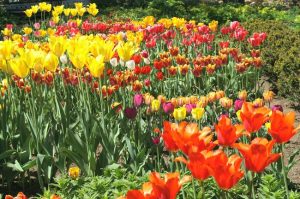
For a brilliant spring display, tulip and other spring flowering bulbs need to be planted in the fall.
Chilling out:
Spring-blooming bulbs need to be planted in Autumn so they will have time to form strong roots before the ground freezes. The best time to plant them is mid-September through late October when the soil temperature falls below 60°F. This allows roots enough time to develop.
Bulbs need time to get established before winter’s freezing weather sets in, and they need to spend enough time in cool soil temperatures to be properly chilled.”
Good bulbs gone bad…
When buying bulbs, look for ones that are plump and firm; avoid any that are soft, rotted, moldy, dented or nicked.
Although the ideal time for planting bulbs is September and October,
technically bulbs can be planted right up until the ground freezes.
Once purchased, it’s important to get bulbs in the ground as soon as possible to prevent them from drying out. If you can’t plant them right away, be sure to store the bulbs in a cool, dark place and plant them as soon as conditions permit.
Keeping bulbs cool is important: if temperatures during storage exceed 80°F for too long, flower buds can be killed, especially heat sensitive bulbs like tulips.
Well grounded:
Many winter hardy bulbs are left in the ground year after year and can provide years of seasonal color in your landscape. To make the most of your time and money investments be sure to give them a good start. To that end, it’s always best to have a soil test done before adding bulbs to your garden. A pH of 6.0 to 7.0 is optimal for most bulbs. Adding limestone or wood ash can raise pH if needed, while additional sulfur or aluminum sulphate can help lower a too-high pH. Your soil test results will tell you what amendments you need (if any), and give you detailed information on recommended amounts. (See Soil Testing for more information on how to have a soil test done.)
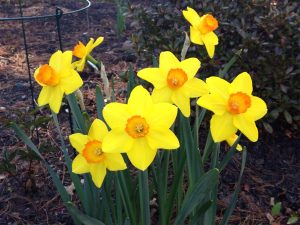
Daffodils benefit from being periodically dug up and divided. Clumps that become overcrowded end up being full of lots of small, undersized bulbs, because the area has become too crowded for bulbs to expand. (Photo by Catherine Horgan)
Fall planted bulbs must be well rooted before the ground freezes, so timing and preparation is key for a successful design.
Where, oh where?
Spring flowering bulbs can cover a lot of ground–literally. They not only bloom in a fabulous range of colors, shapes and sizes, they also thrive in a wide variety of conditions. For a list of bulbs that grow well in our area along with their bloom times, see our Spring Blooming Bulb List.
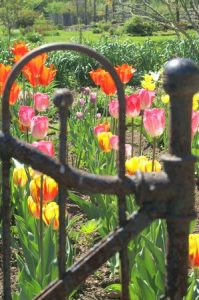
Consider planting groups of bulbs near entrances and along walkways where they can be enjoyed by visitors and passers by.
As a rule, bulbs grow best when planted in areas that have well-drained soil, where they will receive full sun to light shade. When deciding where to place them, keep in mind that it’s often still cold and bleak when the first spring bulbs break through. Consider planting them where they can be seen from inside the house–that way you can enjoy their sunny disposition without having to experience winter’s lingering chill first hand. Some other prime viewing areas: next to walkways and entry doors, under deciduous trees, in front of evergreens and in open flower beds.
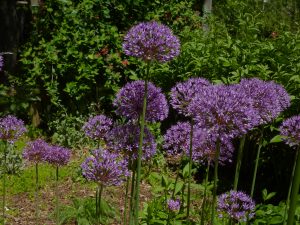
Tall alliums can make a dramatic statement. Planting them behind later sprouting perennials will help hide yellowing foliage. (Photo by Betty Scarlata)
When it comes to color, spring bulbs come in every shade imaginable, from vibrant primary hues to soft pastels–so countless combinations are possible. And since most bulbs only bloom for about 2 weeks, they don’t compete color-wise with flowers that bloom in summer or fall so design away!
For more garden design ideas, see our fact sheet on the Basics of Flower Gardening.
Most bulbs bloom for about 2 weeks or so depending on temperature.
Drift away:
Regardless of where they are sited, bulbs tend to look best when planted in masses or large drifts, not one here and one there. Planting in natural looking clumps also looks better than setting flowers in thin, straight lines. Try planting large numbers of bulbs (200 or more) in those areas that are more than 30 feet from windows and walkways for added punch.
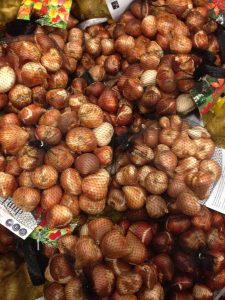
For the best display, plant bulbs in large numbers rather than individually or in straight rows. Buying in bulk can save money and excavating larger areas saves time. (Photo by Margaret Montplaisir)
When planting large numbers of bulbs of the same size, it’s easier to excavate the whole area to the proper depth, instead of trying to dig individual holes. Bulbs can then be laid out more easily, and the soil (and any amendments) can simply be filled in around them. But when planting bulbs in between other plants, or when planting bulbs of different sizes, it might be easier to plant them individually rather than disturbing established plantings.
Faded glory:
One of the biggest consideration when deciding where to plant spring bulbs is how to deal with the yellowing foliage. However, it’s very important that leaves remain on the plant after flowers have finished blooming and not be removed or mowed off until they turn yellow and die back naturally. Those decaying leaves manufacture nutrients which are stored for next year’s growth and bloom and are essential to the plant’s survival. If the foliage is removed too early, the plant loses its ability to “recharge” itself, weakening it, and causing it to eventually die off.
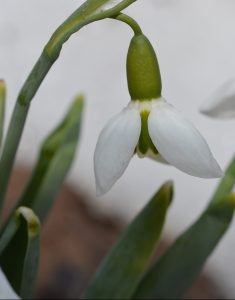
Bulbs like these snow drops can be “naturalized” or planted outside of bed areas. But be sure to plant them in areas that won’t need mowing late spring. (Photo by Catherine Horgan)
While the foliage on smaller bulbs such as snowdrops and squill will fade fairly quickly, the leaves of larger bulbs –like tulips and daffodils — can take several weeks to die back.
Here are some strategies for coping with yellowing bulb foliage:
- Interplant spring-blooming bulbs with cold-tolerant annuals, such as pansies
- Use groundcovers such as periwinkle or pachysandra
- Plant bulbs in between perennials like hostas, daylilies, and ferns
- Locate bulbs behind taller perennials or shrubs
- Plant bulbs under low-growing groundcover shrubs like junipers, cotoneasters, or roses
Depth Perception:
Making sure bulbs are planted at the proper depth is key to bulb success, so be sure to check the instructions that comes with each variety of bulb you have purchased. Proper planting depth for each species should be clearly specified.
As a general rule, bulbs are planted 2 1/2 to 3 times the diameter of the bulb itself. This estimate should be adjusted based on the type of soil they are being planted in however, with bulbs set somewhat deeper in sandy soil and somewhat shallower in heavy soils.
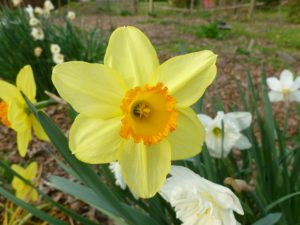
Bulbs need time to get established before winter’s freezing weather sets in, and need to spend enough time in cool soil temperatures to be properly chilled. (Photo by Betty Scarlata)
Correct planting depth is key. Shallow planting of tulips and daffodils is a common cause of failure to thrive or return to bloom a second year.
Cold Comfort:
Spring blooming bulbs are hardy and generally do not require protection from the cold. However, 2″ of mulch can be applied after the ground is frozen to protect bulbs from heaving caused by alternate freezing and thawing; and to prevent premature emergence during warm spells in winter. For more info, see MULCH for the HOME GROUNDS
Well…water!
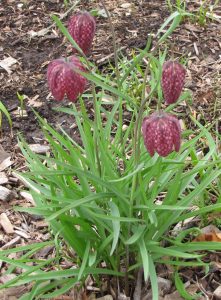
Be sure the soil doesn’t dry out during the drought spells that can occur in fall and early winter –since this is the time when bulbs’ roots are forming.
(Photo by Theodora Wang)
Once your bulbs are tucked snugly into their beds, be sure to water them thoroughly. Watering will help settle the soil and provide needed moisture for the bulbs to start rooting.
Be sure the soil doesn’t dry out during the drought spells that can occur in fall and early winter –since this is the time when bulbs’ roots are forming. Avoid over-watering though, which can cause bulbs to rot.
Bulb Bandits:
Unfortunately, it’s not only winter-weary humans who find spring flowering bulbs highly attractive. Deer, rabbits, voles and other animals love them too and enjoy to dining on the foliage, flowers, and bulbs of many spring bloomers. If critters are a problem in your area, try covering susceptible bulbs with wire mesh screening. This allows the shoots to grow through the holes, while keeping pests out.
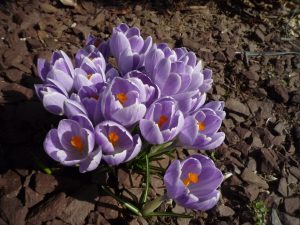
Crocus are among the bulbs most likely to be eaten by animals. Other critter favorites include tulips and grape hyacinth; but adding a little protection in the fall and spring can increase your chances for success. (Photo by Betty Scarlata)
There are a number of repellents on the market which can also be effective. Consult your local Cooperative Extension office or our Master Gardener Helpline for up-to-date pest control advice.
Daffodils, which are poisonous, are generally left alone by deer and rodents. Other bulbs that are less likely to be damaged by animals include ornamental onion and squill. Bulbs that are most likely to be eaten by animals include tulips, crocus, and grape hyacinths. To learn the susceptibility of each bulb type, download Landscape Plants Rated by Deer Resistance.
Forcing the issue
Many of the bulbs that are planted outdoors can be made to flower indoors weeks earlier by potting them up in the fall and “forcing” them. The process involves placing newly potted bulbs in a cool (35°-50°F) location for 10 to 15 weeks to allow for root development.
They can then be “forced” or induced to bloom early by bringing them into a warm room where they can begin to grow well ahead of the spring thaw. The most popular spring bulbs for indoor flowering are hyacinths, tulips, daffodils and other narcissi, and crocuses. Others, such as Siberian squill, star of Bethlehem, snowdrops, grape hyacinth, and Dutch and reticulata iris are also attractive and force well. For how to’s, check out FORCING BULBS FOR INDOOR BLOOM
Plant it forward:
Even though spring may seem a long way off right now, a little planning this fall can bring sunny drifts of daffodils and sweeping swaths of crocus to your yard to brighten those chilly spring mornings. So plant yourself –and the rest of us – a sweet spring surprise this fall. You’ll be glad you did!
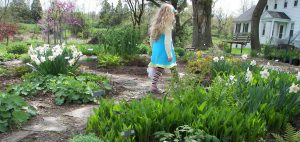
Few plants are as eagerly anticipated as the flowers that bloom in the spring! Daffodils, tulips, crocus, and the other early bulbs are a welcome change from winter dreariness. To be able to enjoy these blooms in your garden next spring, fall is the time to plant!
References
For more on planting and caring for Spring Bulbs see:
